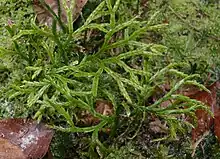| Diphasiastrum complanatum | |
|---|---|
 | |
| Scientific classification | |
| Kingdom: | Plantae |
| Clade: | Tracheophytes |
| Clade: | Lycophytes |
| Class: | Lycopodiopsida |
| Order: | Lycopodiales |
| Family: | Lycopodiaceae |
| Genus: | Diphasiastrum |
| Species: | D. complanatum |
| Binomial name | |
| Diphasiastrum complanatum | |
| Synonyms[1][2][3] | |
| |
Diphasiastrum complanatum,[4] common names groundcedar,[5] creeping jenny, or northern running-pine, is a species of clubmoss native to dry coniferous forests in colder northerly parts of the world. Under the original name Lycopodium complanatum, this was an inclusive superspecies that included a number of other species now known to be biologically separate.
Distribution
As the species is currently recognized, it has been found in Canada, Greenland, northern and central Europe including montane regions of the British Isles, Russia, China, Japan, India, Thailand, and the northern United States.[6][7][3][8]
Description
Diphasiastrum complanatum is a perennial herb spreading by means of stolons that run along the surface of the ground. Above-ground stems tend to branch within the same geometric plane (hence the specific epithet "complanatum," meaning "same plane"). Strobili are vertical borne in groups of up to 4 at the ends of some of the branches.[9]
References
- ↑ Tropicos
- ↑ The Plant List
- 1 2 Family Lycopodiaceae, genus Lycopodium; world species list
- ↑ Holub, Josef Ludwig. 1975. Diphasiastrum, a new genus in Lycopodiaceae. Preslia 14: 97--100
- ↑ USDA, NRCS (n.d.). "Lycopodium complanatum". The PLANTS Database (plants.usda.gov). Greensboro, North Carolina: National Plant Data Team. Retrieved 24 June 2015.
- ↑ Diphasiastrum complanatum in Flora of North America
- ↑ USDA PLANTS Profile
- ↑ Flora of China, Lycopodium complanatum Linnaeus, 1753. 扁枝石松 bian zhi shi song
- ↑ Wilce, J. H. 1965. Section Complanata of the genus Lycopodium. Beih. Nova Hedwigia 19: i--ix, 1--233, plate 40.
